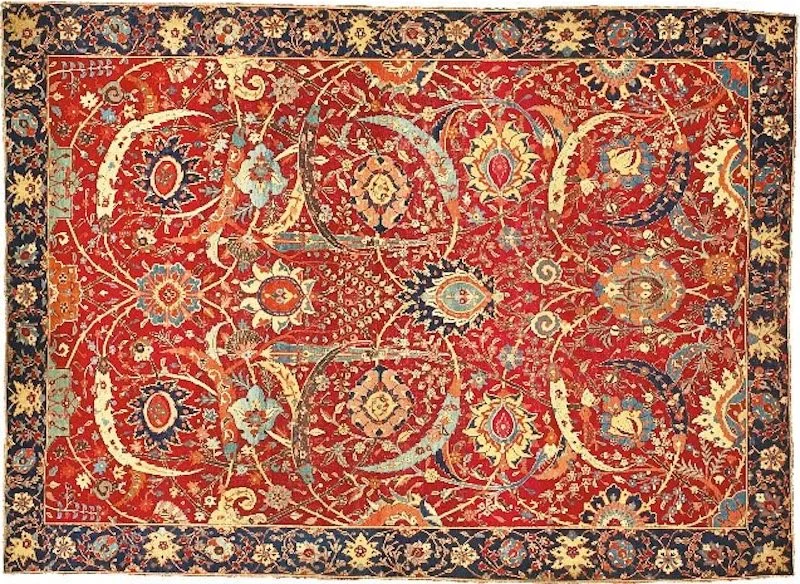How are the values, and prices of rugs determined
The pricing and valuation of an antique rug, akin to any artwork, are influenced by numerous factors. Fundamentally, the cost or value of an antique rug is dictated by the market, reflecting the price a buyer is willing to pay.
Prior to this, rug prices hinge on the amount dealers are prepared to spend to acquire them. The selling price set by dealers depends on the rug’s size, rarity, wool quality, weave, color, preservation state, age, design, and the interplay of these attributes.
Antiquity significantly impacts a rug’s value assessment. The most coveted rugs are often the antique, particularly those from the late 19th century and between the 15th and 18th centuries. Their appeal lies in their quality, as antiques were crafted with superior materials and received considerable time, effort, and attention. Among the oldest rugs, those in good condition are highly valued, not only for their rarity but also for their unmatched aesthetic appeal compared to contemporary productions. Generally, oversized rugs cost more than smaller ones, although this may not hold for rare and collectable pieces.
Values are somewhat based on intrinsic factors, independent of fleeting aesthetic trends. However, trends do influence rug values as demand for specific designs increases and the supply of these unique items dwindles over time. This demand can drive up prices, at least temporarily. But as trends shift and fads wane, the value of “in vogue” items risks decreasing.
Conversely, rugs deemed collectable, rare, and in the best condition tend to retain their value over time. These pieces, the crown jewels of carpets, have proven to be the safest investments and have appreciated significantly in value.
Modern and antique Persian rugs remain interior design staples, as they have for centuries. The various classifications and prices of these rugs can bewilder those unfamiliar with the rug world. To date, the world’s most expensive rug is a Persian Kerman rug, sold at Sotheby’s in New York for $34,000,000.

Rugs can range from a few hundred to hundreds of thousands of dollars. The difference between low-cost rugs and those auctioned at Sotheby’s for a luxury market may seem elusive. Let’s demystify the pricing of Persian rugs.
Decoding Persian Rug Prices
The value of a rug isn’t solely determined by knot density. While the number of knots per square centimeter is crucial, it’s not the only factor. Higher knot density allows for more intricate artistry, hence higher prices.
Authentic Persian rugs are entirely handwoven, with each knot individually crafted. The rug-making process involves long hours at the loom, tying thousands of knots daily. However, numerous preparatory steps precede weaving, including shearing sheep, preparing wool, producing silk, and a complex dyeing process. This material is then used to create the warp and weft, transforming it into a beautiful artwork
Some rugs take months, even years, to make. The finer the materials, the longer the production time, and the greater the value. The time invested influences the price, reflecting the effort in production and the design details that delicate materials enable. Thus, while knot count contributes to the price, it’s only part of the equation.
Materials significantly impact rug values
Silk rugs, highly durable and capable of accepting natural dyes well, are the most valuable. Their sheen, absent in wool and cotton rugs, and the realistic design details they allow make them labor-intensive and time-consuming to produce, which is reflected in their price.
Size also affects rug prices
Larger rugs command higher prices. Many oversized rugs are woven on large looms specifically made for that rug.
Rugs woven on a single large loom are the most valuable, considering the time and materials used in palace-sized rugs. Each additional centimeter adds hundreds more knots to be handwoven, causing the price to rise exponentially beyond a certain size.
Uniqueness and Design Influence Rug Values
While the factors discussed so far are crucial in rug evaluation, uniqueness and design are paramount in determining price.
No two rugs are identical, but rug styles began to standardize in the 1500s, particularly in major weaving centers like Tabriz, Kerman, Heriz, and Tehran. This led to the production of rugs with similar designs and colors, a practice that continues today.
Generally, rugs with common designs are priced lower than unique, artistically crafted pieces from these regions. Rugs designed by renowned artists, such as Mohtasham in the late 1880s, command higher prices. Rugs from specific regions also hold more value. However, truly unique rugs are the most expensive, valued more for their artistic merit than their physical attributes.
Color usage, especially unusual or trendy combinations, also impacts a rug’s value. Rugs dyed with natural dyes, if not faded and still vibrant, significantly increase in value compared to those dyed synthetically.
Condition’s Impact on Rug Prices
A rug’s value increases with careful maintenance. Avoiding exposure to sunlight, which can fade the colors, and preventing wear from children running on it are essential for preserving its condition and value. A well-maintained rug always holds more value than a stained one.
A rug is considered vintage at 30 years old and antique at 100 years. As a rug ages, some oxidation and wear are expected, but the better its condition, the more its value increases over time. It’s crucial to entrust the care of the rug to a specialist in antique rug cleaning, as the use of laundry chemicals can instantly devalue your rug.

Figalli Oriental Rugs
We do not sell rugs. We bring rare works of art to your home in the form of rugs.
Our services
You are Protected
Copyright © 2023 Figalli Oriental Rugs, All rights reserved. Desenvolvido por Agência DLB – Agência de Marketing Digital em Porto Alegre
